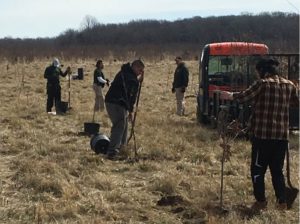By McKay Jenkins
On the late July day that President Trump called my hometown a “rat and rodent-infested mess” where “no human being would want to live,” I found myself dumping 200 pounds of compost into a vegetable garden across the street from a Baltimore methadone clinic. The compost had been cooking in my backyard for almost a year and included a dozen large Hefty bags of leaves from our silver maple and black cherry trees and all the watermelon rinds, avocado skins, and broccoli stems my family of four had eaten over the last 12 months.

The finished compost was a beautiful thing, full of vast colonies of red wriggler worms that had been turning in a green metal barrel beneath the sour cherry tree in our backyard. Every ounce of organic matter that had fallen onto our one-eighth of an acre or been tossed from our kitchen had been transformed into a rich, integrated growth medium whose diverse, biochemical interactions would help transform depleted soil into a potent source of community nourishment.
Even more beautiful were the garden beds where we turned the compost. Planted on an abandoned lot, the gardens were situated across the street from the Glenwood Life Counseling Center, an addiction clinic in northeast Baltimore. The neighborhood was a “food desert” in more ways than one: there were no supermarkets in the area, so people had no access to fresh produce; and there were very few native plants, so songbirds and butterflies no longer came around looking for a meal. But on the day I arrived, children scrambled on a new swing set, in what the neighborhood was now referring to as “the park.” Raised vegetable beds were bursting with bright yellow cherry tomatoes. Native black-eyed Susan, coneflowers, and butterfly weed formed a tapestry of yellow, purple, and orange, mobbed by monarch and tiger swallowtail butterflies. The garden absorbed rain that once cascaded off the abandoned lot and joined storm water and trash in the Chesapeake Bay.
